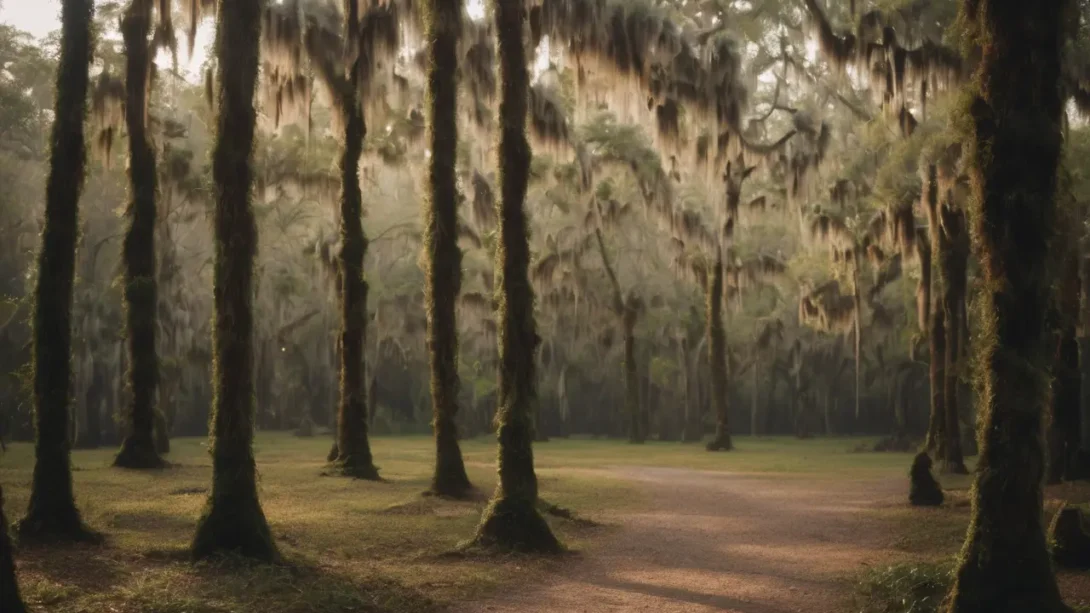Spanish moss (Tillandsia usneoides), with its ghostly drapes hanging from oak and cypress trees, is a quintessential symbol of the Southern United States’ landscapes. This epiphytic plant, often seen swaying gently in the breeze, adds a mysterious charm to the scenery. Despite its common name, Spanish moss is neither Spanish nor a moss but belongs to the bromeliad family, related to pineapples and air plants. A frequently asked question about this ethereal plant is whether it harbors bugs. This article delves into the fascinating world of Spanish moss and its inhabitants, dispelling myths and highlighting its ecological significance.
Spanish Moss
Spanish moss is not a parasite but an epiphyte, which means it lives on other plants for physical support without extracting nutrients from them. It adorns trees in long, silvery-gray strands, absorbing nutrients and moisture directly from the air through its leaves. This unique adaptation allows Spanish moss to thrive in humid environments without competing with its host trees for resources.
Its habitat extends across the southeastern United States, from Virginia to Texas, flourishing in both wild settings and landscaped areas. Spanish moss prefers environments with high humidity and indirect sunlight, making the Southern coastal plains an ideal setting for its growth.
Common Inhabitants of Spanish Moss
Bugs and Insects
Contrary to popular belief, Spanish moss itself does not attract a plethora of pests but can be home to various insects that find refuge in its dense, tangled clumps. These inhabitants typically include:
- Spiders and Ants: These common residents use Spanish moss as shelter and hunting grounds, contributing to the ecosystem’s balance by preying on other insects.
- Moths and Beetles: Certain moth larvae and beetles may also reside within the moss, where they find food and protection. These species are usually specific to their host plants and do not pose a threat to humans.
- Chiggers: The myth that Spanish moss is infested with chiggers (mite larvae) is widespread but largely unfounded. While chiggers can be found in various outdoor environments, Spanish moss is not their preferred habitat, and encounters with these pests in moss are rare.
Beneficial Insects and Ecosystem Role
Spanish moss provides essential ecological services by offering habitat and protection for beneficial insects. These include pollinators and predatory insects that help control pest populations. The dense structure of Spanish moss also supports a microecosystem that contributes to biodiversity, offering nesting materials and shelter for birds and other wildlife.
Myths and Misconceptions About Spanish Moss and Bugs
The eerie appearance of Spanish moss has given rise to several myths, particularly about its supposed infestation with pests like chiggers. However, research and observation have largely debunked these notions. While it’s true that any outdoor plant can come into contact with various insects, Spanish moss is not a preferred environment for many pests harmful to humans.
- Chiggers Myth: The belief that Spanish moss is teeming with chiggers is one of the most persistent myths. Chiggers are more likely to be found in grassy or bushy areas rather than hanging from tree branches in Spanish moss. Instances of chigger bites from contact with Spanish moss are often due to the moss having fallen to the ground where chiggers actually reside.
- Misidentification of Insects: Many times, what are thought to be harmful pests in Spanish moss are actually benign insects or the larvae of beneficial insects. Proper identification is key to understanding the true nature of these inhabitants.
How to Handle Spanish Moss Safely
Despite its relative safety from harmful pests, handling Spanish moss with care is advisable, especially when harvesting it for personal use or decoration. Here are some tips to ensure safe interaction with Spanish moss:
- Wear Gloves: Protecting your hands with gloves can prevent any potential skin irritation from the moss or minor scrapes from tree bark.
- Inspect for Wildlife: Before collecting or moving Spanish moss, gently inspect it for any visible critters that may have made the moss their home.
- Pre-Treatment: If you’re concerned about potential pests, pre-treating the moss by soaking it in water or letting it dry out in the sun can help dislodge any unwanted guests.
Managing Pests in Spanish Moss
For those using Spanish moss in landscaping, gardening, or as indoor decor, managing potential pests is straightforward with a few simple practices:
- Natural Predators: Encouraging the presence of natural predators, such as birds and beneficial insects, can help keep pest populations in check within Spanish moss.
- Regular Monitoring: Keeping an eye on your Spanish moss and the plants it adorns can help you spot any signs of pest infestation early, allowing for prompt action.
- Eco-Friendly Treatments: If pests are detected, consider using mild, environmentally friendly pest control methods. For example, a light spray with a soap and water solution can deter many soft-bodied insects without harming the moss or other plants.
The Benefits of Spanish Moss Beyond Its Aesthetic Appeal
Spanish moss is not only valued for its haunting beauty but also for its ecological contributions. It plays a vital role in its ecosystem, offering more than just an atmospheric element to the landscapes of the Southern United States.
- Air Purification: Like many plants, Spanish moss contributes to air quality. It absorbs pollutants and carbon dioxide while releasing oxygen, functioning as a natural air purifier in the environments it inhabits.
- Moisture Retention: In its natural habitat, Spanish moss helps regulate moisture levels. By capturing and slowly releasing water, it aids in maintaining a balanced ecosystem, especially in areas prone to drought.
- Wildlife Support: Beyond offering shelter and nesting materials for birds, Spanish moss serves as a habitat for beneficial insects and provides food for various species. Its presence enriches biodiversity, creating a more robust and resilient ecosystem.
Cultural and Historical Significance
Spanish moss has woven itself into the cultural fabric of the South. Its image is deeply embedded in Southern gothic literature, folklore, and visual arts, symbolizing mystery, endurance, and the complex beauty of the Southern landscape. Additionally, it has historical uses ranging from stuffing material in upholstery and mattresses to traditional medicinal applications, showcasing its versatility and importance to Southern heritage.
Conclusion
Spanish moss, a distinctive feature of the Southern United States’ landscapes, is much more than a picturesque plant. It harbors a variety of life, contributing to ecological diversity while largely remaining free of harmful pests. The myths surrounding Spanish moss and bugs are largely unfounded, with simple precautions sufficient to safely handle and enjoy this plant.
Beyond its visual appeal, Spanish moss plays a crucial role in air purification, moisture retention, and providing habitat and food for wildlife, highlighting its ecological importance. Its cultural and historical significance further enriches its value, making Spanish moss a cherished symbol of the South.
Appreciating Spanish moss involves recognizing both its beauty and its role in the natural and cultural landscapes. By debunking myths and understanding how to interact with it safely, we can continue to enjoy the mystique and ecological benefits of Spanish moss for generations to come.



